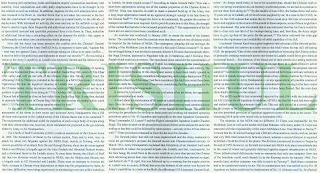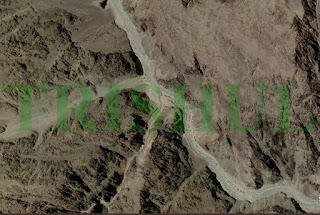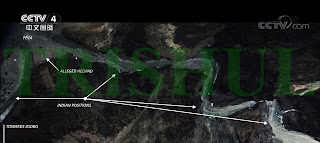















Inference: Whenever two neighbouring
countries, when negotiating the delineation (on maps) and demarcation (on
ground) of the mutually-applicable international boundaries (IB), resort to
previous international treaties and historical paperwork relating to customary
laws and traditions, this is not the case with Mainland China and India
because, while the latter has documentation of the McMahon and Johnson-Ardagh
Lines, the former has no such corresponding historical treaties or maps in its
possession, since all such documentation was transferred from the Kuomintang
(Nationalist) government in 1949 from Nanking (Nanjing) to Taiwan, where they
today are preserved in a hardened underground tunnel complex located underneath
the National Chiang Kai-shek Memorial Hall at Taipei’s Zhongzheng District.
And without such documentation, China finds it impossible to agree on any legal
parameter that is required for delineating and demarcating any IB and hence
always insists that such documentation be superceded by a “political settlement”.
It is for this reason that Mainland China will NEVER agree to negotiate the
delineation and demarcation of not just the LAC, but even a legally-binding IB.
How Tibetan Ineptitude Reduced Pandit Nehru's Policy Options On Tibet
Inference: While popular perception
dictates that India’s first Prime Minister Pandit Jawaharlal Nehru needs
to be repeatedly excoriated for his government’s nonchalance in the face of
stealthy military incursions by Mainland China into eastern Ladakh throughout
the 1950s and 1960s, and for the disastrous and misguided “forward policy”,
which constituted the actual casus belli for the Sino-Indian border-conflict of
1962, little-known historical factoids instead prove that it was the sheer
ineptitude of the Tibetan government between 1949 and 1950 that forced Pandit
Nehru to compromise with Mainland China throughout the 1950s.
Tibetan Uprising Origins
The CIA Starts Helping
Raising Of Special Frontier Force
CIA Wants Out, KGB Wants In
CIA Stirs Unrest Inside TAR, While R & AW Manipulates Dharamsala
Galwan River-Valley Clash Explained
34 45 40.71 N, 78 13 6.79 E
The first signs of discomfort
in India started when the China a few days ago began pressing hard for another
round of Corps Commander-level meeting to kickstart talks on the Panggong Tso Lake
standoff. The PLA even moved a request for a Corps Commander-level meeting on
June 16. India, however, declined and had conveyed to China’s interlocutors
that a higher-level meeting would only be possible after complete disengagement
from the Galwan Valley. This decision was taken at the highest levels. The
issue on the table from an Indian standpoint were two semi-permanent structures
with tents on PP-14 (Patrolling Point) in Galwan. The PLA-BDR troops had moved
back some distance following local commander-level talks, but had refused to
remove these structures. At PP-17 in Gogra/Hot Springs, China had apparently
raised objection to some Indian Army hutments. In the recent past, PLA-BDR troops
have acted in a pattern where they move up, build tented structures and then
move back after talks without demolishing what they had made. This was flagged
off by the Indian Army as a way to make re-occupation easier at these heights.
However, pending resolution of these issues on Galwan, China was keen to start
conversation on the Finger Areas of Panggong Tso. At that stage, a high-level
meeting took place in Delhi on June 12 where it was decided that India will
insist on complete resolution of the dispute in Galwan before moving on to Panggong
Tso. South Block was, in fact, gearing up for a more protracted conversation on
getting the PLA-BDR troops to move back from Finger-4 in Panggong Tso. It was
felt that the PLA would be more belligerent there as it had moved into
advantageous ground.

It was the People’s Liberation
Army’s (PLA) insistence of constructing an observation post (OP) at Indian
patrolling point (PP) that resulted in the violent scrap between the two sides
on the evening of June 15. The post would have helped the PLA to not only
observe Indian troop movements towards the Karakoram mountain range, but also would have had the
capacity to interdict army vehicles plying on the Darbuk-Shyok-Daulet Beg Oldi
(DS-DBO) road. Most importantly, the OP was on India’s side of the Line of
Actual Control, or LAC. While India’s External Affairs Minister S Jaishankar red-flagged this issue in his
conversation with his Chinese counterpart Wang Yi, it is quite evident that the
PLA had a pre-meditated plan in the garb of de-escalation to change the agreed
alignment of the LAC and push out Indian Army from PP-14. This would have been
hugely detrimental to Indian interests. Set-up in 1978 by the Indian Army, PP-14
is on a ridge that overlooks both the Galwan River Valley and the Galwan Nullah,
which joins the Shyok River on whose bank the DSBO road is being build by
Indian Army and BRO engineers. The June 6 meeting between the military
commanders of China and India had even defined the number of
troops to be present at each point leading to PP-14. But even as the
de-escalation was on, the PLA wanted to put up an OP near PP-14 on grounds that
it wanted to observe the dis-engagement of troops. This was strongly objected
to by 16 Bihar Battalion’s Commanding Officer Col Santosh Babu, who rightly saw
this as the breach of laid-down rules of disengagement. Around dusk on Monday,
June 15, Col Santosh and his Company Commander went up to PP-14 and told his
PLA counterpart to pull down the OP. A heated exchange ensued, more troops
rushed in from both sides, and punches were thrown. The PLA, which has a base
camp down from the ridge near the Galwan River, rushed in more troops in
armoured personal carriers to the nearest road-head to PP-14. Initially, the
Indian Army troops were present in significant strength, but the PLA soon
outnumbered them. While China’s Foreign Minister Wang Yi has asked India to
punish its troops for breach of discipline, the fact is that the PLA wanted to
set up the OP as part of its efforts to redefine the LAC. PLA officers had told
Indian Army officers before the scrap that the alignment of the LAC was behind
PP-14. The illegal OP would not only have made the Indian position at PP-14
untenable, but also given a huge tactical advantage to the PLA with the option
of interdicting Indian Army movement on the soon-to-be-constructed bridge with field
artillery or direct-fire. If the OP had been allowed to be set-up the Indian Army
supplies to DBO camp ahead would have been at the mercy of the PLA. With more
than 600 troops involved in fisticuffs and hand-to-hand combat, the mountain ledge on which
the fighting was taking place gave away to a landslide. This led to casualties
on both sides as the troops fell into the Galwan Nullah and River, with a
section of Indian Army troops being isolated on the other bank of the
tributary. Drenched in the ice-cold water of Galwan River and with temperatures
running way below zero, the Indian Army troops had nowhere to hide against the
elements at an altitude of 16,000 feet ASL. A large number of Indian casualties
are on count on standing out in the open in wet clothes to prevent the PLA from
taking control of PP-14. The PLA engaged in a show of strength on the morning
of June 16 by bringing in more armoured personnel carriers to the nearest road
head to intimidate their Indian counterparts. The PLA had also linked the
dis-engagement on PP-15 (in Gogra/Hot Springs) to the Indian Army allowing the
OP being built near PP-14 on the Indian side. It was the courage of Col Santosh
and his men that prevented that.

The clash between Indian Army and
PLA troops in which both sides suffered casualties on June 16 began at around 7pm
in the Galwan Valley when an Indian Army squad of about 50 soldiers, led by
Colonel Santosh Babu, reached a contested site near PP- 14. The soldiers were
unarmed, as part of a protocol between the two sides. Forward troops patrolling
the disputed border either do not carry guns, or, if they do, keep them slung
on their backs with the magazines in pouches and not clipped on. The PLA
soldiers were supposed to have withdrawn from the location under a
de-escalation plan discussed by senior commanders from both sides on June 6. But
the Indian squad found the PLA troops, in violation of that understanding, did
not pull back and their tents and an OP was still around. It was when Col Babu
and his team confronted the PLA soldiers about their continued presence at the
site that the clash broke out and the situation swiftly escalated as the PLA
soldiers refused to vacate their positions and the Indian soldiers removed the
tents and the OP that were on the Indian side of the LAC. In a matter of
minutes, the soldiers were locked in hand-to-hand fighting that triggered a
seven-hour violent face-off involving reinforcements from both sides. The
clashes spread out from the PP-14 area to a nearby narrow ridge overlooking the
river. It was there that both sides suffered casualties. The soldiers exchanged
blows, threw stones at each other, and the PLA troops attacked Indian soldiers
with iron rods and nail-studded clubs. Some soldiers, from both sides, fell
into the water and their bodies were later retrieved on Tuesday June 16 morning.
India’s Ministry of External Affairs (MEA) corroborated this sequence of events
on June 17 when it detailed a conversation between Foreign Minister S
Jaishankar and his Chinese counterpart Wang Yi. In a phone call, Jaishankar
told the Yi that the PLA soldiers’ actions “reflected an intent to change the
facts on the ground in violation of all our agreements to not change the status
quo”. Jaishankar, in his call, underscored the need to implement the June 6
understanding reached by the military officials of both sides as part of a
phased de-escalation strategy to ease tensions that had persisted for weeks.
The plan was discussed between Lt Gen Harinder Singh, GOC of the Indian Army’s Leh-based
XIV Corps, and Maj Gen Liu Lin, Commander of the People’s Liberation Army’s
(PLA) South Xinjiang Military District. According to it, the PLA was supposed
to have fallen back around 5km to the east of the location. It had retreated a
bit last week but came back to retake the positions they had temporarily
vacated. On June 15, the PLA deployment had numerical superiority over the
Indian side—more than 250 of them were present in the area when the Indian
squad, despite being fewer in numbers, demanded that the PLA remove the
structures and withdraw in order to return to status quo. The PLA was, however,
adamant on holding its ground. It seemed prepared for a face-off. In the first
wave of clashes on June 15 night, Col Babu and two other soldiers were
grievously hurt and succumbed to their injuries. Reinforcements arrived from
the Indian side within an hour and the brawl spilled over to beyond midnight,
and the face-off involved more than 500 soldiers from both sides. The clash
took place in pitch-dark conditions and resulted in 20 deaths on the Indian
side, and possibly 46 casualties including injuries on the PLA side, pushing
the bilateral relationship between the two nuclear powers to an all-time low. They
were the first Indian casualties in a border skirmish with the PLA since
October 1975 when PLA troops ambushed an Indian Army patrol in Arunachal
Pradesh’s Tulung La sector and shot four soldiers dead. The deadly confrontation
came on a day when Army delegations from India and China held talks at two
locations along the LAC--one involving Brigadier-ranked officers who met at the
Galwan Valley, and the other between Colonel-ranked officers at Hot Springs--as
part of continuing efforts to resolve the standoff. The Indian Army
acknowledged three casualties in a statement issued on June 16 afternoon. It
later issued another statement in the evening saying, “17 Indian troops who
were critically injured in the line of duty at the stand-off location and
exposed to sub-zero temperatures in the high-altitude terrain have succumbed to
their injuries, taking the total killed in action to 20.”
Galwan River-Valley
Gogra-Hot Springs
Panggong Tso Lake
Depsang Bulge-Trig Heights-Burtse
The PLA has marked its
presence at a crucial Y-junction near the Burtse patrol camp in Ladakh. Barely
30km south of the strategically important Daulat Beg Oldie ALG, this
Y-junction is also known as ‘bottleneck’ in Indian strategic circles because any
patrol seeking to reach either Point 10 or Point 13 along the Line of Patrol,
must cross this junction. It is interesting to recall that the PLA had crossed
the Y-junction and stopped barely 1,500 metres short of the Burtse camp in April
2013. Both India and China use the route along Raki Nala, north of Y-junction,
for patrolling purposes and it is not uncommon for both sides to run into each
other. In
1976, the Govt of India had constituted a China Study Group (an in-house
think-tank of the MEA), which revised the patrolling limits along the LAC. As
can be seen from the map, patrolling points 10, 11, 11A, 12 and 13 fall
slightly short of the LAC.
IA & PLA Martyrs



































































































































